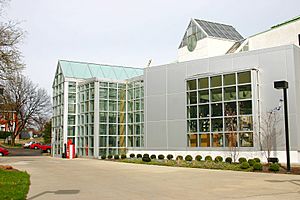Butler Institute of American Art facts for kids
 |
|
 |
|
| Established | 1919 |
|---|---|
| Location | 524 Wick Avenue, Youngstown, Ohio, 44502 |
| Type | American art |
The Butler Institute of American Art (often called BIAA) is a special museum in Youngstown, Ohio, USA. It was the very first museum made just for American art. A kind local businessman named Joseph G. Butler, Jr. started it. The museum has been open and free to the public since 1919. Its beautiful original building, designed by McKim, Mead and White, is even on the National Register of Historic Places.
Contents
Exploring American Art at the Butler Institute
The Butler Institute of American Art has many amazing artworks. These pieces show different parts of American history and culture. The museum's collection helps visitors understand the country's past through art.
Famous Paintings to See
One of the most famous paintings at the Butler is Winslow Homer's Snap the Whip. This artwork shows kids playing outside a one-room schoolhouse. It's a great look back at how schools used to be.
Did you know there are two versions of Snap the Whip? The other one is at the Metropolitan Museum of Art in New York. The Butler's version has mountains in the background, but the other one does not.
In 2007, the museum bought a painting by Norman Rockwell called Lincoln the Railsplitter. This painting cost $1.6 million! It used to belong to a famous businessman named Ross Perot.
Art from America's Past
The museum also has a special collection of paintings. These artworks show Native Americans from the southwestern United States. These paintings were once part of Joseph Butler's own collection.
Other important paintings include a picture of George Washington's wedding. There's also William Gropper's Youngstown Strike, which shows the 1937 Little Steel Strike. Another famous piece is Albert Bierstadt's The Oregon Trail, painted in 1869.
Modern Art and More
The Butler Institute also has a gallery for modern art. Here, you can see a large painting by Alfred Leslie called Americans: Youngstown, Ohio. It shows people connected to the Butler museum in the 1970s. The museum also has many works by the artist Robert Motherwell, who was known for his Abstract Expressionist style.
Growing and Changing: The Butler's Expansions
The Butler Institute has grown a lot over the years. New parts have been added to the building to make more space for art and activities.
New Wings and Centers
In 2000, a large new section called the Beecher Center was built. It was created with Youngstown State University. This center focuses on bringing together technology and art in new ways.
Two years later, in 2002, the Andrews Pavilion was added. This part of the museum has a sculpture area, a gift shop, and a café. It's a nice place for visitors to relax and enjoy the art.
In 2006, the Butler bought the building next door, which used to be a church. They turned it into a center for education and performing arts. This means more space for classes and shows!
Supporting the Museum
In October 2007, the museum held an art auction. People donated art from all over the country. About 125 art lovers came to see and buy the pieces. All the money raised helped pay for experts to create an updated list of all the artworks in the museum. It also covered the cost of printing this new catalog.
In October 2009, the museum featured the work of Denis Peterson. He is a Hyperrealist painter, meaning his paintings look incredibly real, almost like photographs. His work was part of a traveling show of famous Photorealist artists.
Technology and Accessibility
The Butler Institute of American Art has also embraced new technology. In December 2021, the museum started working with Aira Tech Corp. This partnership gives visually impaired visitors access to a special app called Aira.
The Aira app is easy to use. Visitors just open the app and tap a button. Then, they are connected with an Aira agent. This agent helps describe each piece of artwork, making the museum experience better for everyone.
See also
 In Spanish: Instituto Butler de Arte Americano para niños
In Spanish: Instituto Butler de Arte Americano para niños


